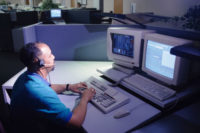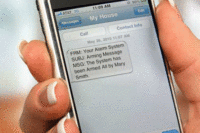Personal emergency response systems (PERS) traditionally have worked only in a user’s home, enabling users to summon help with the push of a button — typically on a pendant that the user wears. But recent years have seen the introduction of mobile PERS offerings (mPERS) that can work outside the home using cellular service for communications to the central station.
Many sources say mPERS is the fastest growing category within the PERS market — and security dealers not offering mPERS already may want to consider doing so. Before you jump in, though, it’s important to understand the market and the technology and what’s required to support an mPERS offering.
The mPERS Market
The biggest problem that security dealers make when getting into the PERS market in general is that they “vastly underestimate how different the sales channels are and how much churn there is,” comments Josh Chandler, president of LiveFree Emergency Response, a Pocatello, Idaho-based manufacturer of PERS equipment.
A typical PERS customer might stay with a company for 15 months to two years, Chandler says. “You need to have a real commitment to it with a real sales program to continually get referrals,” he says, adding, though, that the mPERS market has a bit less churn than the traditional PERS market.
According to Brock Winzeler, general manager of Ogden, Utah-based mPERS manufacturer Freeus LLC, an average mPERS account stays with the service for 30 months and dealers can recover their investment in the system within two to four months — which is considerably quicker than for a traditional alarm system. Although monthly monitoring fees for PERS and mPERS are comparable to those for a traditional security system, equipment costs are considerably less, requiring less time for dealers to recover their investment.
To help maximize ROI, Winzeler also advises dealers to offer black pendants, which are less likely to show wear and tear and can be recycled for future customers when the initial customer cancels service.
A possible explanation for why the typical mPERS customer has a lower churn rate than a typical PERS customer is that sources say the typical mPERS customer is somewhat younger and more active than the typical PERS customer.
“Mobile PERS is best sold as an alternative for seniors who are more active,” Chandler comments. Older users may not leave the house frequently, and when they do they are likely to be with someone, he explains.
Lynbrook, N.Y.-based medical alert provider Lifewatch Inc. (Lifewatch USA) was one of the first companies to offer mPERS several years ago and initially it was a hard sell, recalls Lifewatch CEO Evan Sirlin. People felt that a cellphone was all they needed to summon help. “[Since then] people have figured out that it’s much simpler to push a button or to use . . . automatic fall detection than deal with a smartphone,” Sirlin observes.
Like Chandler, Sirlin sees the typical mPERS customer as someone who is fairly active and who frequently ventures out alone. Sirlin notes that if a lone person were to fall in a parking lot in most metro areas someone would quickly help and summon emergency personnel if needed. Nevertheless, he says many people are concerned that no one will be nearby to help and that getting to the cellphone or dialing or speaking or turning it on may not be possible. But when they carry an mPERS button or wear an mPERS pendant, they feel safer, Sirlin comments. People also like knowing that monitoring centers already know their medical history, location and phone numbers of friends and family, he adds.
“This provides a more appropriate, dignified response,” Sirlin says.
For reasons such as these, mPERS is gaining substantial ground with dealers that offer it. “For most dealers, mPERS is at least 25 percent to 30 percent of their new PERS production, maybe up to 40 percent for some,” Chandler says.
mPERS Challenges
Mobile PERS isn’t for all PERS customers, though.
One concern is that mPERS systems cost more on both an upfront and ongoing basis. Sirlin notes that mPERS equipment costs more — and because of the additional cost for cellular service and GPS location technology, companies usually have to charge at least $40 a month in recurring fees. Traditional PERS monitoring usually costs less than that, he says.
Another issue pertains to battery life. While traditional PERS pendants use batteries that can go for years without replacing, mPERS devices — like other cellular devices — need to be frequently recharged. Keeping them charged can be challenging for elderly people who may have memory challenges; and some seniors have difficulty using the connectors that are built into traditional cellular devices. Some mPERS manufacturers attempt to overcome these limitations by providing an audible verbal alert when equipment needs recharging and by providing a cradle for charging. Nevertheless, Chandler notes that some seniors still may not keep devices charged.
Chandler cautions against overselling mPERS. He notes, for example, that one capability of some mPERS systems is the ability to send an alarm when the user leaves a pre-specified geographic area. Some caregivers may view this as a great way of keeping Alzheimer’s patients from wandering off; but Chandler says that option only really works in an institutional setting such as a nursing home, where someone other than the patient is responsible for keeping the mPERS battery charged.
“You have a product [that appears] built for memory care but you have people who can’t easily remember to charge the product,” he comments.
It’s worth noting that mPERS can be implemented as an app on a smartphone, but according to Sirlin, the market for those products is limited because the user has to hold the smartphone at the ready in order to achieve a prompt response time. A more typical smartphone application might be used by university students who might walk home at night from a party with their finger over the emergency button designed into the app, he says.
Who Does The Installation?
An important factor that can impact PERS profitability and customer satisfaction and churn is whether the dealer installs the system for the customer or leaves it to the customer to handle installation — and experts are divided about which is the best approach.
Williamston, S.C.-based Blue Ridge Security Systems only installs traditional PERS systems, which are dependent on a shorter-range wireless connection between the pendant and a base station connected via a phone line, broadband connection or cellular connection to the central station. Perhaps because of considerations like these, the company almost always installs the system for the customer.
“We talk to the customer, find out exactly what kind of distance they have and the exact limitations,” explains Judy Keenan, senior account representative for Blue Ridge. “We test [the system] with the central station, make sure it’s working properly and that it’s totally supervised so we know when we walk away that it’s totally supervised.”
Using a similar logic, some dealers may want to hand-deliver mPERS systems to customers. But Sirlin argues that this isn’t necessary. The logic behind this thinking is that cellular communication is available almost everywhere; the system doesn’t need to be plugged into a phone or computer jack; and the end user is likely to be younger and more tech-savvy than the user of a traditional PERS system.
A third installation scenario may be an option, depending how a dealer markets PERS and mPERS. Rochester, N.Y.-based dealer Doyle Security Systems Inc. sells those systems heavily through healthcare agencies — and in many cases the agency prefers to handle installation, notes Chris Marsh, director of sales for Doyle Medical Monitoring.
Some central stations that offer monitoring for mPERS systems, including Union, N.J.-based Affiliated Monitoring, will ship mPERS equipment directly to the end user or healthcare agency, eliminating the need for the dealer to maintain an inventory of the equipment.
Dealers offering mPERS should make sure that operators handling the calls have appropriate training.
Doyle Security Systems monitors mPERS systems in-house and, as Marsh explains, all of the company’s central station operators go through extensive training — including riding with salespeople on calls — before they begin handling any alarm signals.
Franklin, Ohio-based dealer and central station operator VRI specializes in medical monitoring and signals from mPERS systems are handled by the company’s top-tier operators — those with the greatest experience and highest skill levels, says VRI CEO Chris Hendriksen.
Some third-party central stations also monitor PERS and mPERS, offering another option for dealers that may not have their own central stations or who would rather outsource this type of monitoring.
Dealers offering PERS and mPERS also may want to consider investing in sales and prospect tracking software designed for call centers, advises Daniel Oppenheim, vice president of Affiliated Monitoring, Union, N.J. Because the revenue generated per customer is smaller for PERS than for traditional security systems, you need different infrastructure to track leads and opportunities, Oppenheim says.
Getting into the mPERS business entails many considerations — from how to position and target the product to who should install the equipment and who should monitor it. But with proper planning, mPERS can be a profitable growth area to add to a dealer’s operations. n
Marketing to Seniors: The Legalities
Monitoring Activities of Daily Life
Affiliated Monitoring Catalyst Conference to Help Dealers Expand PERS Business
Dealers selling PERS or mPERS systems are marketing to seniors. And with that comes an extra level of responsibility with regard to marketing.
“People need to be more careful about understanding what regulatory requirements apply to them and following them,” advises Michele Shuster, a partner with New Albany, Ohio-based law firm Mac Murray, Petersen & Shuster LLP, which specializes in marketing compliance.
Shuster notes, for example, that if state or federal regulators get a lot of complaints about a program or service marketed to seniors, they are likely to be quicker to investigate the provider — and in some cases, any penalties levied may be higher.
When it comes to advertising materials, dealers should take care to comply with what Shuster refers to as “UDAP” guidelines, aimed at preventing “unfair or deceptive acts and practices.” Among other things, these guidelines specify that advertisers must be able to substantiate any claims made and must disclose any terms that someone might want to know before making a purchase decision, she explains.
Having a law firm versed in these guidelines review advertising materials is a good practice, Shuster notes.
But perhaps where dealers can most easily run afoul of regulatory requirements is with regard to outbound telemarketing to cellphones.
“The law says you can’t use an automated telephone dialing system to call anybody without consent,” Shuster says. Some types of calls require written consent while others are permissible as long as the called party already gave his or her number to the caller in the ordinary course of business.
As Shuster notes, though, there are some gray areas with regard to the definition of an automated telephone dialing system. According to the strictest interpretation, any phone that could be attached to an automated dialing system could be considered an auto dialer — and according to Shuster, that would include everything but a rotary phone.
The FCC is currently considering a petition asking for clarification on this, but until that is provided, dealers may want to use extra caution in outbound telemarketing. Shuster notes, for example, that dealers can have cellphone numbers “scrubbed” from calling lists by running the lists against two specific databases. One database, available from Interactive Marketing Services, contains known cellphone numbers. The other, available from Neustar, contains phone numbers that have been ported from landlines to cellphones.
A key development area for PERS is monitoring activities of daily life (ADL). Some mPERS systems already have some ADL capabilities, notes Chris Marsh, Doyle Medical Monitoring.
In a typical ADL installation, a dealer might add sensors on refrigerators or elsewhere in the home to track how active a senior is. The system could be programmed to alert the central station if the refrigerator isn’t opened for a certain period of time, for example. Using that information, a central station operator could then check in on the senior to find out if he or she simply has been eating out or if, instead, he or she has no appetite — in which case it might be appropriate to alert a caregiver.
Some sources we spoke to say they have seen little demand yet for ADL monitoring. Others say they get inquiries about it but people balk at the price tag, as both the upfront and recurring costs typically need to be higher than for traditional PERS and mPERS systems.
It’s an important area to keep an eye on, however, as the technology is likely to become more sophisticated and costs are likely to come down over time.
Affiliated Monitoring’s Catalyst PERS Sales & Marketing Conference will bring together the best minds in the PERS industry to help dealers expand their businesses. Catalyst sessions will be focused on the sales and marketing skills and tools every PERS and medical alert company needs. Catalyst will provide a forum for dealers of all sizes and marketing channels to discuss and learn about new opportunities. Catalyst will be held May 17 – 19, 2016 at the Naples Grande Beach Resort in Naples, Fla.
“Unlike most traditional conferences, Catalyst was built from the ground up as a PERS-focused conference in response to dealers looking for information and an opportunity to share their experiences,” stated Mike Zydor, managing director of Affiliated Monitoring. “Whether you are an existing PERS company looking to grow your business or you are interested in starting getting into the PERS market, Catalyst was designed specifically with you in mind. Anyone who has spent time in PERS knows that marketing and selling in this industry is unique. With Catalyst, we’re responding to a consistent refrain from the industry and filling the void.”
The cost to attend is $595 inclusive of all sessions, events, the afternoon Everglades Excursion and all food and entertainment. The early bird special is $395 but is expiring soon.
To register for Catalyst ’16 and review the agenda and content visit www.affiliated.com/catalyst.
More Online:
For more PERS coverage, visit SDM’s website, where you’ll find the following articles:
“How 4 Dealers Found Success in PERS”
“PERS Continues to Expand with Greater Functionality”
“Cellular Providing a Catalyst for Enhanced PERS Offerings”






